#tunisian metal
Text



I love stats and so this annual feature is fun for me
I love the whole thing where people give you a number(s) between 1-100 and you tell them the song(s). If you feel so inclined
#Rammstein#Ауткаст#Ауткаст band#znous#tunisian metal#hanzel und gretyl#Lindemann#Monolith Deathcult#German metal#neue deutsche härte#industrial metal#death metal#Spotify
2 notes
·
View notes
Text
My eyes wide shut, jumping in the void
Falling so fast I touched the ground
Not a solution, just an escape
I might awaken again
At least I have tried
Made all I can
Tried to fit the frame
Incorporate the game
I never could incorporate this frame,
and I know I can run, but never find the way out of here
Make up every lie,
even when you're right
Could not make it right
Give up who I am
I never could incorporate this frame,
and I know I can run, but never find the way
I never could incorporate this frame,
and I know I can run, but never find the way out of here
#Myrath#Wide Shut#Tales of the Sands#Music#Heavy Metal#Progressive Metal#Middle Eastern Folk Metal#Tunisian Band#Tunisian Metal#Oriental Metal#Spotify
1 note
·
View note
Text
youtube
Dance by Myrath
0 notes
Text
youtube
Come back to life, you still have a fight left in you
You still have your brave women and men
Resist however you can, despite your hunger and ignorance
your light must prevail over the darkness…in you
#znous band#traslation edited by the band#znousland#hardcore political punk tounsi#tunisian music#tunisian metal#Youtube
0 notes
Text
Got a new set of Tunisian hooks with cords on the ends since I was struggling to fit the entire length of a baby blanket on the one I had. It took a little getting used to the hook being wooden and shaped differently, but the project is going a lot more smoothly now and I'm not getting hand cramps after a row and a half.
#still wish the hooks were metal but what can you do#also it's just as cheap on amazon to get an entire set as to try to find just the size you need#so now I have more Tunisian hooks than I could ever need#apparently I need to learn more stitches and techniques
3 notes
·
View notes
Text
i like knitting way more than crocheting and yet i own way more crochet hooks. fascinating.
#i think i keep hoping the next ones will make me like crocheting more#and they never do.#actually i know exactly why i bought all of them and none of it was for that reason.#my initial batch was from the dollar tree just to try out crochet and see if i could get into it#(actually i needed them for a provisional cast on for a hat i still havent knit)#(but i figured whilei had em i might as well try crochet)#then i got into tunisian crochet and i got a set of plastic tunisian crochet hooks#which i lost somehow???#so i bought another set (first one was a gift at least so i didnt buy the same thing twice with my own money)#and those are great i still love them#but i needed smaller sizes cuz they only go down to like 3.75 mm#and i needed like ~2mm sizes with more ergonomic handles#so i could do finer work#so i bought a CHEAP set of bamboo hooks that came with metal hooks in very small sizes#(and they were so cheap i had to go over all of them with sandpaper to even make them usable)#and i got a set of the susan bates twist and lock because i prefer metal and i didn't have any metal bates-style hook heads#but i wish they came in more sizes :( i like the handle for the most part#and the yarn cutter#but they ALSO only go down to like 3.75 mm#and now im waiting on a set of METAL interchangeable tunisian hooks#because i prefer metal and i LOVE tunisian crochet#so it should be nice to finally have metal hooks i can use for that#i had a bamboo hook my dad made for me that i learned tunisian crochet on#and it was AWFUL!!!#it was SO sticky. not like‚ to the touch‚ but like.#the yarn stuck to it so bad. the friction. YUCK!!#and i like the plastic ones alright. but they're no metal.#like i cant express to you the difference because its mostly just the feel.#but i prefer the feel of metal tools all the way. all the way.#i love the glide
2 notes
·
View notes
Text

Ayyur | Prevail | 2023
Tunisian Black Metal
Artwork by Ahmed Mejbri
#Ayyur#Prevail#Tunisia#Tunisian Black Metal#Black Metal#music#band#art#artwork#artist#Ahmed Mejbri#Hidden Rooms Recordings#Bandcamp
9 notes
·
View notes
Text
Further Down the Rabbit Hole I Suppose
Thanks to the support on Ko-fi I managed to get this tunisian crochet hook set I've wanted for a while. Which it would be great if there were more metal interchangeable tunisian crochet hook sets available at a reasonable price. Made sure to try everything after the interchangeable needles I got off Amazon had several issues. Thankfully the only problem was one of the stoppers wasn't fully secured on the cord. But the other 3 are fine so I'll live. Can't wait to make a cowl with it or a shawl.


#tunisian crochet#Interchangeable hooks set#Yeah it's Ali Express I know but there's no where else you can find a metal set of interchangeable tunisian crochet hooks for less than $10#All and all it's nice
0 notes
Text
youtube
For all those who would use some good power before another week of 'All the same, old, day by day's. Should also work fine with 'And now for something completely different's too.
Warning: may contain different metals.
0 notes
Text
i am actually using the same diameter crochet hook to redo the tweed, but i crochet much looser with this hook for some reason. no clue why
#they are both tunisian crochet hooks#one plastic one metal#one bates one boye#one longer and one with a thumb grip#could be anything
0 notes
Photo


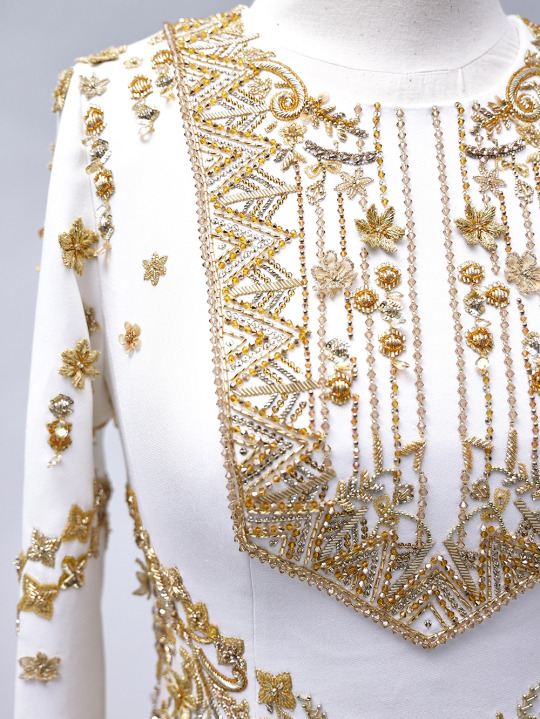
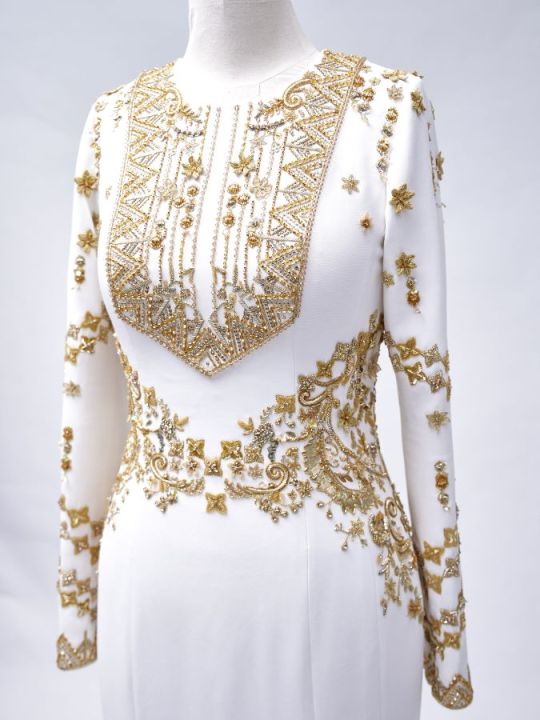


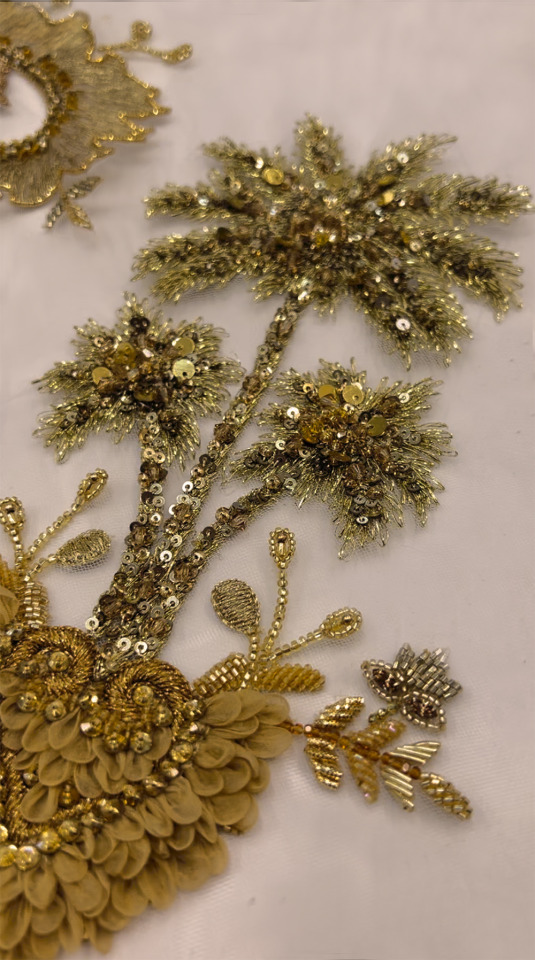


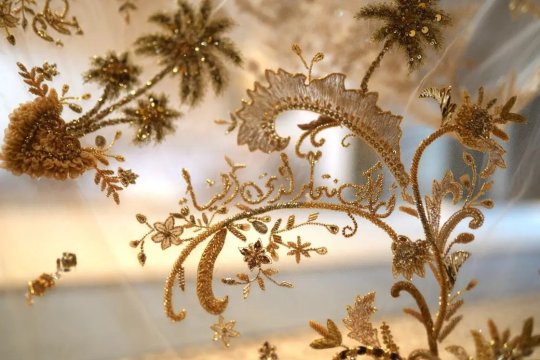
Close-up of Rajwa Al Saif's henna party outfit on 22 May 2023. The dress, by Saudi designer Honayda Serafi, took more than 2,000 hours to create, and includes several hidden messages of love, Vogue Arabia reports.
“Crafted by Saudi designer Honayda Serafi, Al-Saif’s henna dress is a vision in white and gold. The future queen of Jordan celebrated with family and friends in a look that takes inspiration from the traditional Najdi dress, known as Sahabi thoub, which originates from the Najd region of the Kingdom of Saudi Arabia. Keeping in mind the occasion and the family, Serafi made sure to combine the cultural beauty of the Hashemite kingdom of Jordan and the Kingdom of Saudi Arabia to celebrate the union of Rajwa and Prince Hussein beautifully.
Featuring a handcrafted veil and dress, Rajwa Al-Saif’s pristine white henna outfit comes doused in 3D ornaments, made using a mix of silk, metallic threads and traditional reed strings (a signature element of Najdi embroidery). To create this masterpiece, Honayda Serafi took cues from the bride’s personality, attempting to reflect her innate grace, the rich traditions of her land, and her contemporary spirit.
Look closely, and you’ll notice that Al-Saif’s gown is replete with lovingly made details. Featuring a high round neck and full sleeves, the crepe gown features an inverted triangle-shaped bodice that is inspired by the traditional Najdi bodice design, normally worn as a separate piece. As the body-skimming gown continues, it flares out towards the ankles to create a mermaid-esque shape. The bodice of the gown is elevated using embroidery: soft organza flowers share space with geometric shapes and Arabic motifs, all of which are typical to Saudi Arabia and reflect the beauty and traditions of the bride’s homeland.
Rajwa Al-Saif’s veil has also been embroidered with meaningful designs, making this piece so personal to her journey. Seven Jordanian stars adorn her veil to signify the seven-pointed star that sits proudly on the Jordanian flag. What makes this symbol even more special is its religious meaning: The star on the Jordan flag signifies the seven verses in the opening chapter of the Holy Qur’an, and the seven mountains of Amman.
Along with the stars, the veil also features intricate palm trees as a reference to Saudi Arabia, and even some poetry. The words “I see you, and life becomes more beautiful” have been embroidered into Al-Saif’s veil, from Tunisian poet Abu al-Qasim al-Shabi, known for his Andalusian notes. If you’re a fan of Rajwa Al-Saif’s elegant wardrobe, you may already know that the bride-to-be has a soft spot for special symbols when it comes to her clothing. Back in August 2022, when Rajwa was officially engaged to Prince Hussein, she also commemorated the occasion with her clothing—an abaya that was embroidered with two gold birds, symbolizing two souls in love.”
The veil took 760 hours to complete
An exquisite piece of couture requires hours of effort, and Rajwa Al-Saif’s henna outfit is no different. According to the designer, Al-Saif’s veil took 760 hours to complete, and was worked on by a team of experts, craftsman and women. Extending to 10 meters, the piece was made using handcrafted tulle, a process that normally takes close to 2,000 hours of work. As for her billowing gown, the creation is the result of 340 hours of work.
Honayda Serafi: “I am very proud and honored to be part of this historic union”
Speaking on the occasion, Serafi shared, “I am very proud and honored to be part of this historic union between His Royal Highness, Crown Prince Al Hussein bin Abdullah II of the honorable Hashemite family, and Miss Rajwa Khalid Alseif. May they be blessed with happiness and their union be crowned with success.” (x)
804 notes
·
View notes
Text
Crystallize (ROTTMNT One-Shot Preview)
One-shot, Fluff, Rise Donnie, main timeline
You honestly can’t say how all of this got started.
Now don’t get it twisted. You remember the first instance. The fact that not even a few minutes into your lunch period, you’d heard the sound of something banging against metal only to look up and find no one. You remember the following days and the stare that had accompanied them, intent and focused on your hands as you toiled away at the blanket you’d been working on. And you remember by the end of that week, someone sitting two tables over with a book, something that would have barely caught your attention if it didn’t keep happening again, and again, and again.
Same height, same purple hoodie, same heavy stare the second you start working on your project.
You realize they’re trying to be subtle. You know they’re not. Not when they consistently take off minutes after your lunch break is finished. Not when they constantly spare a glance behind themselves as they leave after checking out their books. And certainly not when, after a week of that, they take to you, not your owl colleague, you when your superior kept telling you that this new shift was just going to be about the first few hours, something you’d hate if it didn’t mean you were fully awake.
So you know. You’ve got a pretty good track record of what’s been going on during your shifts and breaks, although you’re pretty sure whoever this person is would likely be annoyed at that fact. You’re just not sure why. Why this person, this man is obsessed with your hobby as thoroughly as he is.
… You think it’s a man. The few sounds you’ve heard coming from his throat sound male and the name you have seen on the account seems like it, but you have no idea what’s behind that purple hoodie of his other than the fact that he seems to have green skin and a mask of the same color as his pullover. Not to mention that getting him to talk feels almost forbidden at this point, at least until he breaks it.
“That’s not the project you were working on.”
Which, just like you expected, is done as weirdly as all your previous interactions, if they can be called that, making you blink and look at the bag next to you.
Of course, he would notice. Even if he’s not a bird, he’s been watching you like a hawk for a month. You turn back to checking in his books, “It was getting a bit too big to work on here, so it’s now at home. This is a transitional project since I haven’t bought the yarn for my next project yet and I have a lot of scraps.”
“The hook is different.”
You check in the last book and follow his gaze back to your bag, smiling at the long wooden hook, “Yep. It’s what I like to use for my scrap projects. It’s a Tunisian crochet hook. You familiar?”
Before you dare look in his direction, your polite smile melting into genuine mirth as his face twitches. You can't be sure, but he looks miffed, dare you say upset since he takes off without another word into the library, and you can only sigh at it as you wonder if he will be present at lunchtime.
#rottmnt#rise donnie#rise of the teenage mutant ninja turtles#rottmnt donnie#rottmnt donatello#I have another version of this that's in-media res and I'm not sure which way is preferable#rise donnie x reader#rottmnt donnie x reader#My writing#donnie writings#tmnt aged up
58 notes
·
View notes
Note
Hi
1 love your blog and podcast
2 I’m really enjoying your weekly Palestinian film recs
3. Do you have more recommendations for Arab and Middle Eastern cinema ?
Thank you ☺️
helloooooo, thank you 🥰 I have a whole sideblog which I don't promote enough called @swanasource where I and my co-mod @thatidomagirl frequently post middle eastern/SWANA film and films made by swana filmmakers in the film tag here:
I myself am still on my journey of watching more swana films (and non-english and non-Western films) so I won't claim to be any sort of exhaustive expert. but here are some of my favourites!
Salt of this Sea (2008). Dir. Annemarie Jacir. Palestinian film about a Palestinian-American woman heisting an Israeli bank
The Persian Version (2023). Dir. Maryam Kershavez. Comedy about an Iranian-American lesbian who gets pregnant after a one night stand and so decides to learn more about her family history.
Kedi (2016). A calming and beautiful Turkish documentary about the cats of Istanbul
Ali's Wedding (2017). A rom-com about an Iraqi-Australian Muslim who falls in love with the Lebanese girl from his mosque who's helping him get into med school.
The Man Who Sold His Skin (2020). Tunisian thriller about a syrian refugee who agrees to let his back be tattooed and be part of a living exhibition by a notorious artist so he can get a visa.
Sirens (2020). A documentary about the queer Lebanese all-girl metal band, Slave To Sirens, set around the Beirut explosion.
In Vitro (2019). A short Palestinian sci-fi film about an elderly woman in an underground bunker trying to describe the world before to a young woman who's only ever known the bunker.
Cairo Time (2009). Dir. Ruba Nadda. Look, this film isn't perfect but It's about a white American woman who's husband is a UN worker in Egypt. She goes to visit him in Cairo, but her husband is waylaid so he sends his bestie played by the beautiful Alexander Siddig to take her around Cairo and oh my GOD the romantic tension of this movie keeps me up at night.
Butterflies (2018). One of my fave movies ever. A Turkish comedy about 3 estranged siblings who have to take a chaotic road trip to fulfil their father's last wishes.
78 notes
·
View notes
Note
did i see something about tusken inspo 👀
To be fair, it's like Tatooine inspiration at large. But yes, much many ideas :D
Oh this is going to be long... *crack knuckles*
Okay so Tatooine is inspired by Tunisia which is not a secret (for the folks that don't know, the name comes from the town Tataouine and the scenes in the movies were filmed in three other Tunisian cities). Added to that is the fact that the Tuskens were inspired by the Bedouins, a nomad people of north Africa.
Now, there is an Umayyad (medieval Islamic dynasty, 661-750) farm in Jordan named Qusayr Amra :

Which gives massives Tatooine vibes.
The Umayyads (and the Abbasid dynasty right after) rules over a large territory, which extend as far as the Maghreb. So the comparison of a Jordan farm to the Tunisia cities used for star wars is understandable.
Now those geographical and chronological markers give me a well of material to get inspiration for Tatooine and the Tuskens. (I includ the Abbasids because they're in the lineage of the Umayyads and the aesthetic match what I think would suit nicely for the Tuskens.)

The ceramic cup in the middle is Umayyad. The decor comes from an antic (Roman Empire) aesthetic that is still very present in this dynasty's art. Now you could replace those vigns by something more space looking, like space oasis flora.
The Kufic inscription would be out of place for the Tuskens. Except if we look into a Kufic calligraphy that appears a bit later which is composed with little characters adorning the letters. What I propose is that the Tuskens could have a sort of writing system composed of pictograms representing their signs. They could carve those pictograms on the cliffs as well as their ceramics or weapons...
This cup is not from north Africa I give you that (like the two next objects, it's from Susa in Iran. That site is way too rich and big....), but with it being Umayyad it doesn't betray the original inspiration for Tatooine. Plus it would look really cool and that's the most important.
(The vase on the left could also look really cool in a tusken hut I think)


All of those are Abbasids. I took the left picture for the bol in the centre but that green one looks great too (I think it's jadeite or nephritis but I'm not sure).
I just think they would look super cool as Tuskens ceramics. The jug on the right is a lil favorite of mine. It's a very luxurious object (both are really) because of the glaze. The blue is obtained with cobalt from Afghanistan (if I'm not wrong, I need to check) which was not an easy thing to get (we're at the 9/10th century here). But the technique itself and the forms are still simple enough that I think it'll mix well with a space nomad tribe culture in a desert.
Now we could look into other dynasties productions and I should look back at my notes on Middle and Near East Antiquity, because there most likely has more things to dive into there.
I don't think Tuskens would use much metal or if they do, it'll be forging with scraps bought from the Jawas. To cut and grave little pendants and ornaments, spikes, that kind of things. But I sort of think the only way to forge for them would be by using their ceramic kilns (if they have any and not just tempory holes dig specially for it), that's why I didn't look into Islamic metal production. I just don't think they'll have forges with them being nomad like that. But it's still a possibility of course.
Anyway, that was a little look into the ideas I've been munching on lately.
#heh not as long as i thought#(that's because i don't have access to my notes right now but that's just a detail)#sw#sw art and culture#tusken raiders#tusken#history#art history#hi tumblr void#tatooine
25 notes
·
View notes
Text
Coptic Women's Headpieces: padded headbands and Palmyran strips
Neither of these have much (...in the first case, any) information out there to make their own post about, but they're both interesting.

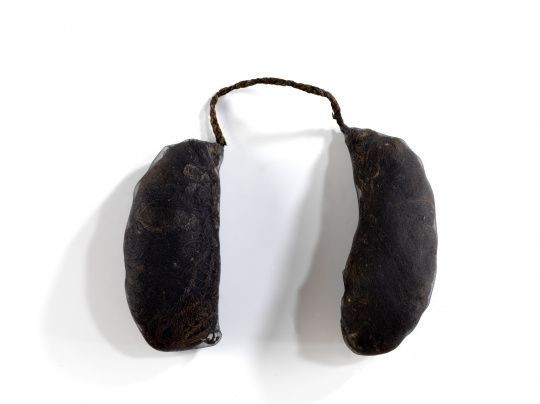
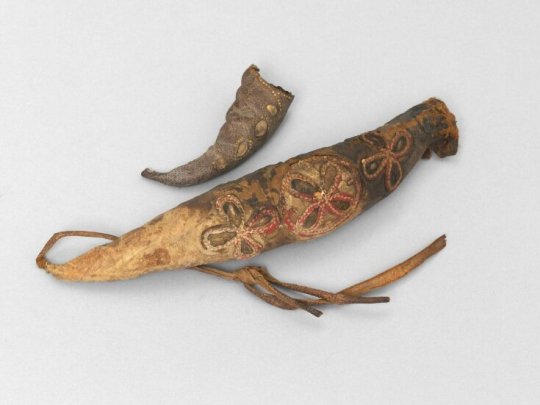

The first are these padded headpieces. In the past I'd only seen the one made of leather with flowers on it in the V&A, which notes its possible usage. However it was only until recently when I began poking around on the French internet when I found more, and better yet, an undeniable depiction of a woman wearing the headpiece. Before this I'd seen some depictions that may be the headpiece being worn, but usually seem much flatter than these were made to be or like they're a more standard gold diadem.
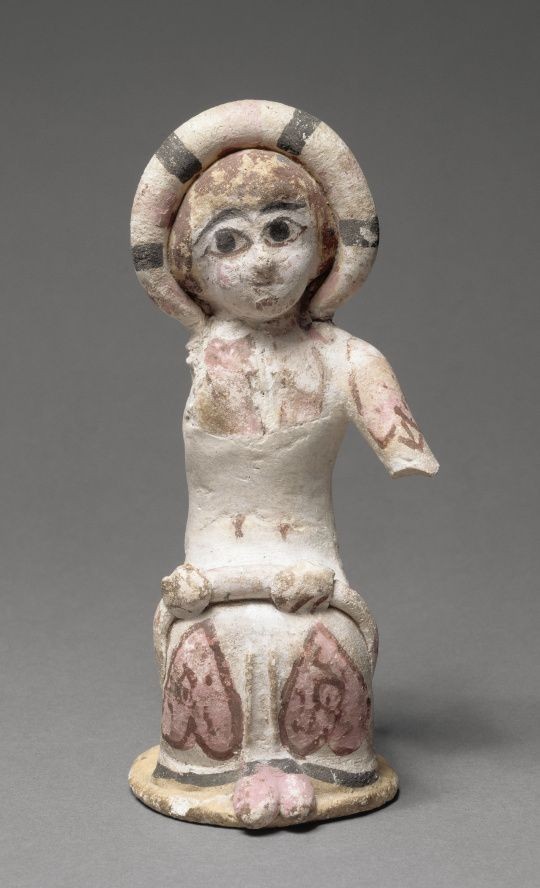
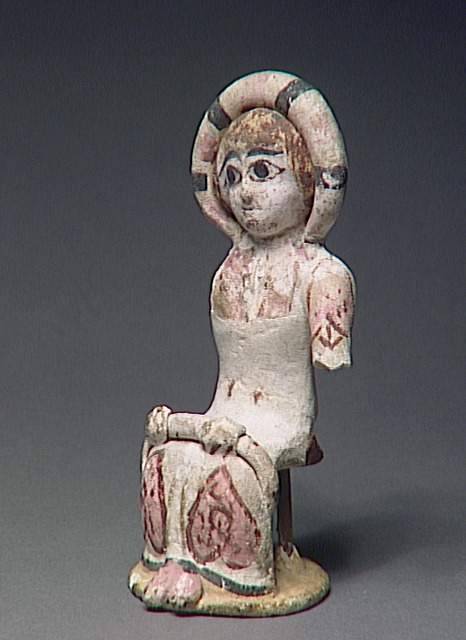
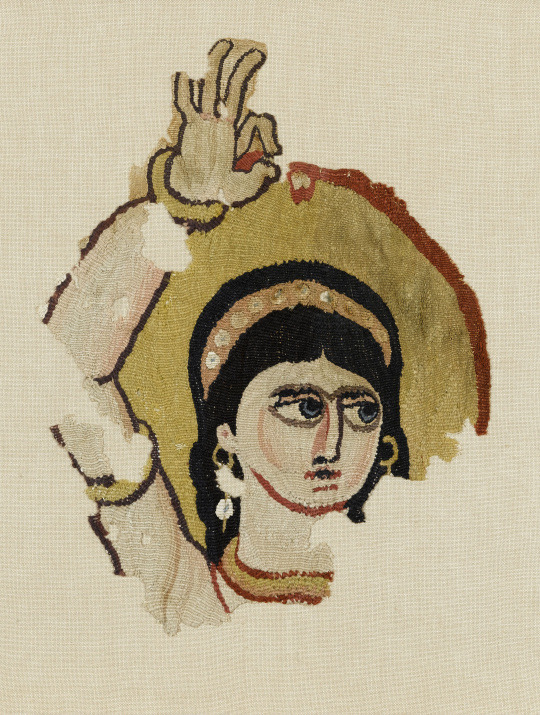
In addition to this, there are a few depictions of Coptic figures wearing these flower bud/petal crowns (more popular in the earlier part of Roman Egyptian art history), which makes me wonder if these were ever used as a base for those.


It's also possible this was out under the turbans worn by women in Coptic art. An example of a bust from Byzantine exists of a woman wearing a turban from Constantinople, and when viewed from the side it can be seen that the volume at the front of her headdress terminates in points near the nape of her neck/her ears. However, this bust also lacks the volume one would expect from the examples if a roll like the extant examples was used.
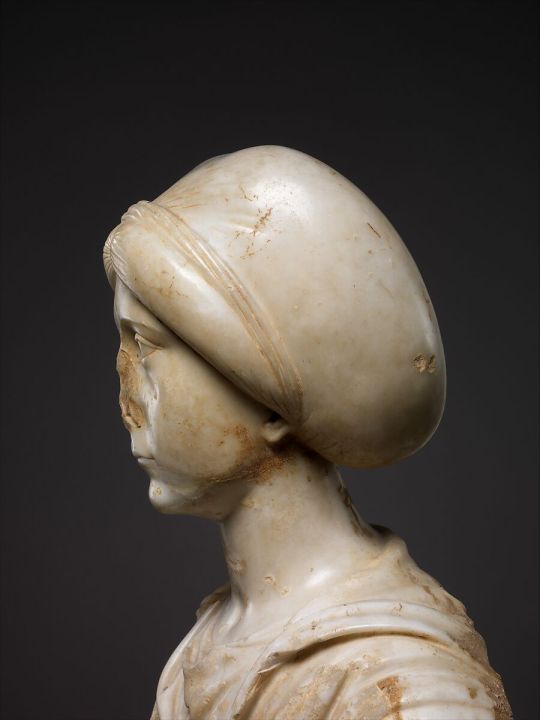
The other piece is one I noticed before, and isn't specific to Egypt, or originated from there. It seems to have come from Palmyra, and is fairly common in the funeral busts we have from there.

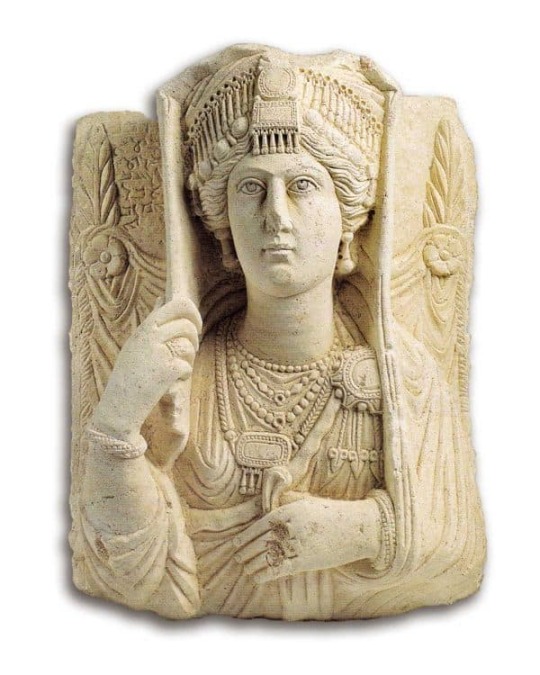
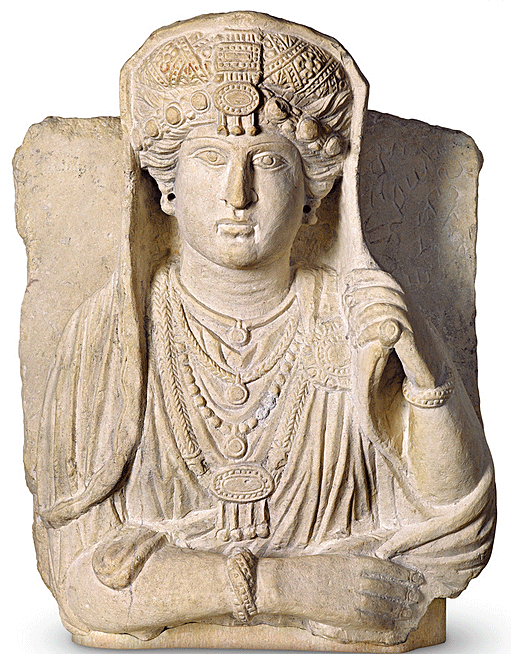
These are small plaques of metal and gems, typically with a few small beads dangling over the forehead. Currently it's supposed that they were attached to a woman's bun in some way.

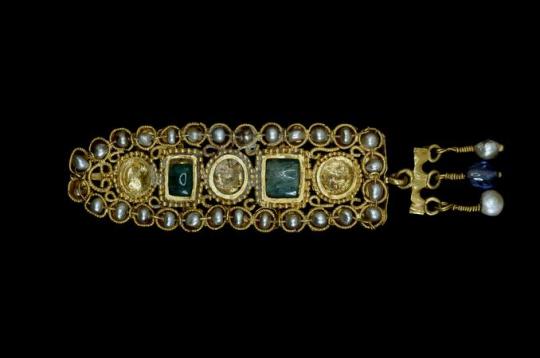
Here's a Roman-era Greek bust and a Roman- era Tunisian example.
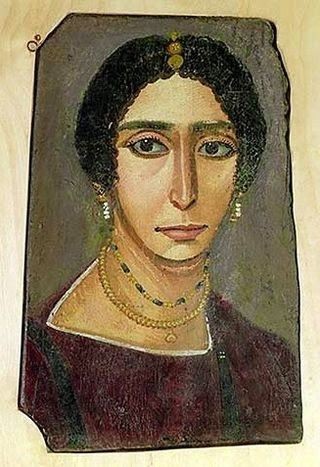
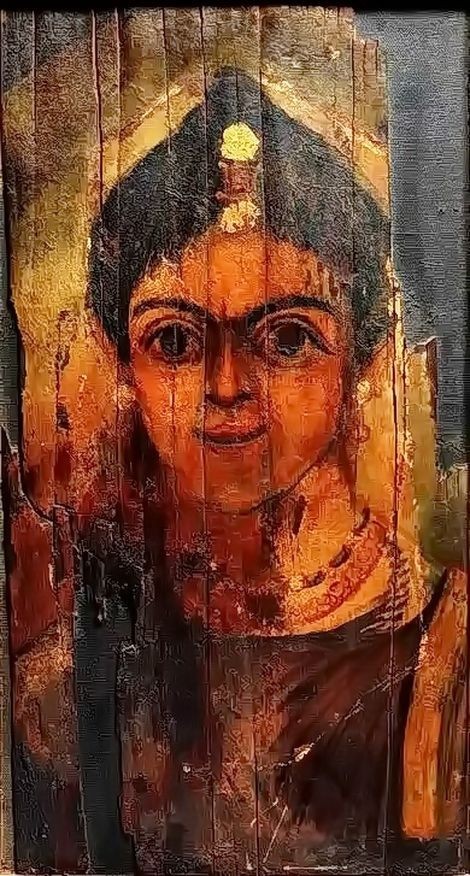



Heres some Roman-Egyptian portraits with similar head jewelry. So far, I haven't found a definitive later Coptic depiction of one being worn, but I don't think that means they stopped being worn before Christianization. It's possibly just a matter of what art has survived and what I've personally seen. Generally, Coptic jewelry is similar to the jewelry from earlier Roman-Egyptian examples, with some more unique examples and examples that were inspired by later trends in the Byzantine Empire.

One of the possible Coptic examples is from the tomb of Theodosea (full disclosure: Theodosea herself was Greek Christian living Egypt, not a Copt in the sense we mean it now, but she's dressed in a way generally common in Egypt at the time. I use "possible Coptic example" here to indicate the contemporary cultural majority of Egypt, which is distinct from the pre-Christian cultural identity of native Egyptians). Theodosea here is identified by Engy Hanna as wearing some type of golden hairnet, with a green pendant with 3 hanging pearls and two strings of hanging beads attached. Because of her palla, it's impossible to tell if she has only one medallion attached to her hairnet or if this is a strip. The overall composition of elements (a cover over the hair, the two strands, center ornament, and a shawl over top the head) are very similar to Palmyran headdresses, though she doesn't wear a turban or the patterned fillet they do.


Recently, I found a bust on an auction site labeled "Roman, probably made in Egypt" from the 1st century, with this ornament but made of a more pliable material- probably fabric. And another on the same site, maybe Egyptian (the information mentions both the terms Gandhara and Greco-Egyptian), with the more typical jeweled look, 2nd-3rd century (which is more into the swing of Christianization in Egypt).



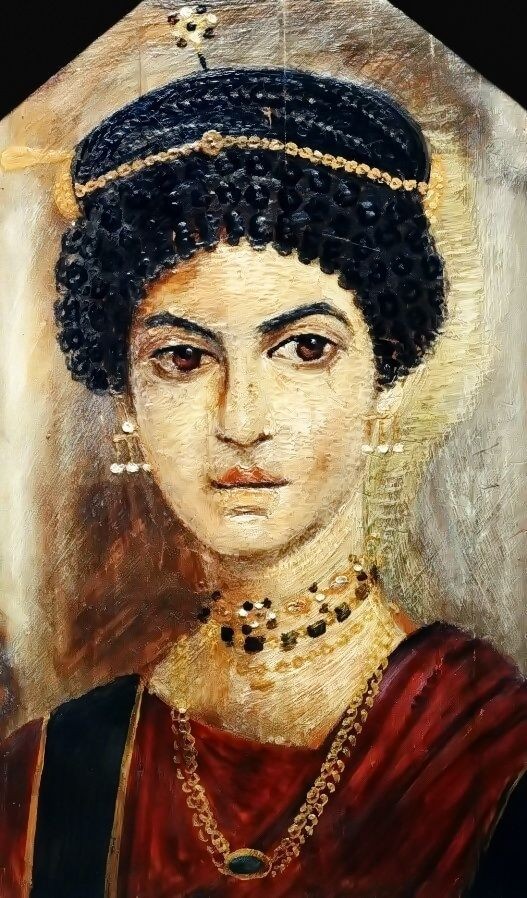

The last aside is another jewelry piece resembling that of Palmyra, though less so: a kind of circlet that appears to be made of chain with a center pendant. The star pendant worn by the second woman also notably resembles the pin holding the strip to the Greek girl's updo. The hanging strands of Theodosea are more blatant, but it's possible these were elaboration on the fashion. This style of jeweled forehead circlet, unlike the headband and strip (I have seen art of Syrian and Egyptian women with a strip, as well as Nubian art of women with a fillet/circlet and a center strip. The latter seems to be a more widely used item than the former two, which I have only seen one depiction each of so far), has remained consistently popular in West Asia and North Africa. Additionally the padded band worn by one of the Palmyran women featured here could be a related item to the padded headband; to know one would have to see the back of her head or find an artifact connecting the two. Even if a relationship can be proven between the Byzantine, Palmyran, and Coptic padded fillets, there is no clear indication of where it originated.
*I am a Copt, and if you are not, do not tag this post talking about "recreations". I find that offensive given the actions taken by Albert Gayet in regard to the clothes he took from graves. It is a simple boundary and you will not "enlighten" me to see how it's fine.*
Sources/Further reading:
https://art.rmngp.fr/fr/library/artworks/femme-assise_terre-cuite_polychromie-technique
https://art.rmngp.fr/fr/library/artworks/bourrelet-de-coiffure-postiches_laine-textile
https://art.rmngp.fr/fr/library/artworks/bourrelet-de-manteau_laine-textile
https://art.rmngp.fr/fr/library/artworks/bourrelet-de-mantelet_laine-textile_textile-matiere_lin-fibre | sources for 3 of the padded fillets and the figurine
https://collections.vam.ac.uk/item/O353014/pair-of-fillets-unknown/
https://www.metmuseum.org/art/collection/search/468716 | the marble bust
https://www.persee.fr/doc/bch_0007-4217_1969_num_93_2_4903 | in German, has photos of carvings with the hair ornament
https://www.sothebys.com/en/auctions/ecatalogue/2016/ancient-marbles-classical-sculpture-art-l16260/lot.59.html | carving of the short haired child
https://www.sothebys.com/en/buy/auction/2022/ancient-sculpture-and-works-of-art/a-roman-marble-portrait-head-of-a-girl-circa-2nd | carving of a girl with a jeweled strip, may be Egypt as the notes say an image of it was published in a work on Greco-Egyptian art and the girl has an "Isis lock" hairstyle
https://www.jstor.org/stable/4241695 | overview of Palmyran jewelry
https://www.britishmuseum.org/collection/object/G_1903-0717-3 | Tunisian example of strip
https://www.livius.org/pictures/greece/thessaloniki/thessaloniki-museum-pieces/thessaloniki-portrait-of-a-girl/
https://womenofegyptmag.com/2020/02/11/what-coptic-artefacts-tell-us-about-women-in-ancient-egypt-part-one/
#Coptic art#Coptic culture#Late Antiquity#Late Antique Egypt#Masr#Copt#Actually Egyptian tag#Cipher talk
98 notes
·
View notes